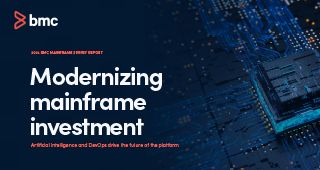In the dynamic landscape of software development, where mainframe systems continue to play a critical role, the adoption of artificial intelligence (AI) is revolutionizing traditional practices. Specifically, the emergence of generative AI presents a paradigm shift in how developers interact with mainframe applications within the DevOps ecosystem. This article delves into the fundamental disparities between using generative AI and conventional AI methodologies in mainframe DevOps and explores how the former augments the developer experience.
The overarching goal of employing generative AI in mainframe DevOps is to enhance the application developer journey. Generative AI operates on the premise of explaining, guiding, and testing mainframe application changes and enhancements. Unlike traditional AI and machine learning (ML) techniques, which predominantly focus on optimizing system performance or detecting anomalies, generative AI takes a proactive stance in empowering developers throughout the software development lifecycle.
Understanding the scope of AI capabilities
Before delving into the nuances of generative AI, it’s important to delineate the capabilities of AI in the mainframe DevOps domain. AI encompasses a spectrum of techniques, ranging from anomaly detection and predictive maintenance to optimization and automation. These methodologies excel in augmenting system monitoring, maintenance, and performance. However, traditional AI falls short in addressing the intricate nuances of the developer journey, such as code comprehension, adherence to coding standards, and efficient testing strategies.
Why generative AI is the optimal solution
Generative AI emerges as the quintessential solution for augmenting the application developer journey in mainframe DevOps due to its innate capacity to comprehend, guide, and enhance code-related tasks. Unlike traditional AI methodologies, which primarily focus on system optimization and anomaly detection, generative AI transcends these boundaries by actively participating in the software development lifecycle. For instance, in code explanation tasks, generative AI not only provides comprehensive insights into code snippets but also automatically integrates explanatory comments, fostering better understanding and collaboration among developers.
Similarly, in code-review scenarios, generative AI offers real-time guidance on adhering to enterprise coding standards and industry best practices, thereby ensuring consistency and compliance across applications. These examples underscore the multifaceted capabilities of generative AI in enhancing developer productivity and facilitating seamless collaboration within the DevOps ecosystem.
Let’s explore five key use cases that demonstrate the efficacy of generative AI in this realm:
1. Explanation: Understand what the code does
Generative AI offers in-depth explanations of code snippets and programs. Leveraging sophisticated natural language processing (NLP) methods, it seamlessly integrates comments into code, improving readability and fostering collaboration among developers. This automated process enhances understanding and streamlines the development workflow, ensuring that developers can grasp the intricacies of the codebase more efficiently, which helps accelerate the development cycle.
2. Review: Receive immediate feedback on code standards
Generative AI plays a pivotal role in code reviews, assisting developers with real-time guidance and remediation suggestions that ensure adherence to predefined standards to promote consistency and compliance across applications. Developers benefit by receiving immediate feedback on their code, which helps them identify and rectify potential issues early in the development process. Consequently, it leads to higher-quality codebases, improved software reliability, and increased efficiency in development workflows.
3. Improve the delivery of your changes
In an era characterized by increasingly complex toolchains, generative AI can significantly streamline the code delivery process. By facilitating quicker root cause isolation and enhancing the resiliency and performance of continuous integration and continuous delivery (CI/CD) toolchains, it expedites mean time to resolution (MTTR). Reduced downtime and faster issue resolution lead to increased productivity and smoother workflows for developers, while businesses experience improved software delivery efficiency, enhanced competitiveness, and greater customer satisfaction.
4. Give every developer a personal assistant
Generative AI functions as an indispensable virtual coding assistant, equipped with extensive knowledge of best practices, design patterns, and syntax. By seamlessly integrating into developer workflows, it provides contextual recommendations and promotes adherence to industry and organizational standards, enhancing developer productivity and code quality. Developers gain real-time guidance, enabling them to make informed decisions and produce high-quality code efficiently . As a result, businesses get accelerated development cycles, reduced error rates, and enhanced software reliability, ultimately leading to improved customer satisfaction and competitive advantage in the market .
5. Efficient testing with minimal viable data
Generative AI revolutionizes the testing paradigm by intelligently analyzing source code and devising optimal testing strategies. By leveraging sophisticated algorithms, it generates test case scripts and tailors datasets to the specific requirements of the application, ensuring thorough coverage while maintaining efficiency. Automation of the testing process saves developers time and effort previously spent creating comprehensive test suites so they can focus more on developing new features and addressing critical issues. For businesses, the adoption of generative AI for test case generation results in improved software quality and reliability . With thorough testing coverage, organizations can mitigate the risk of bugs and performance issues, leading to higher customer satisfaction and reduced maintenance costs in the long run. Additionally, it facilitates faster release cycles, enabling businesses to stay competitive in the market.
Considerations for adoption
When considering the adoption of generative AI in mainframe DevOps, organizations should carefully evaluate several key factors to ensure successful implementation:
- Scalability and compatibility with existing mainframe infrastructure and development processes
- Potential benefits, such as improved code quality, faster development cycles, and enhanced developer collaboration, etc.
- Cost-effectiveness and return on investment, encompassing initial investments in training and infrastructure and the long-term benefits of increased efficiency and productivity
- Alignment with strategic objectives and overall digital transformation initiatives
By carefully weighing these considerations, organizations can make informed decisions about whether and how to incorporate generative AI into their mainframe DevOps workflows.
Conclusion: Generative AI fosters a culture of continuous improvement
In essence, the integration and adoption of generative AI into mainframe DevOps signifies a transformative leap in the developer journey. With enhanced code comprehension and improved testing and adherence to standards, developers are empowered to innovate with unparalleled confidence and agility. This not only accelerates development cycles but also fosters a culture of continuous improvement within organizations.
Embracing generative AI paves the way for enhanced efficiency, reliability, and scalability in mainframe application development. Businesses can expect streamlined processes, reduced time to market, and better software quality. Moreover, the adoption of generative AI sets the stage for future advancements in technology and reinforces the organization’s position at the forefront of innovation in the competitive landscape. Overall, it signifies a strategic investment in harnessing the full potential of AI to drive sustainable growth and success in the digital era.







